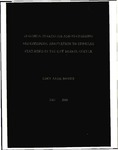Encoding strategies and mechanisms underpinning adaptation to stimulus statistics in the rat barrel cortex
| dc.contributor.supervisor | Denham, Susan | |
| dc.contributor.author | Davies, Lucy Anne | |
| dc.contributor.other | Faculty of Science and Engineering | en_US |
| dc.date.accessioned | 2011-08-26T15:50:42Z | |
| dc.date.available | 2011-08-26T15:50:42Z | |
| dc.date.issued | 2011 | |
| dc.date.issued | 2011 | |
| dc.identifier | 10029499 | en_US |
| dc.identifier.uri | http://hdl.handle.net/10026.1/559 | |
| dc.description.abstract |
It is well established that, following adaptation, cells adjust their sensitivity to reflect the global stimulus conditions. Two recent studies in guinea pig inferior colliculus (IC, Dean, Harper & McAlpine 2005) and rat barrel cortex (Garcia-Lazaro, Ho, Nair & Schnupp 2007) found that neural stimulus-response functions were displaced laterally in a manner that was dependent on the mean adapting stimulus. However, the direction of gain change, following adaptation to variance, was in contradiction to Information Theory, which predicts a decrease in gain with increased stimulus variance. On further analysis of the experimental data, presented within this thesis, it was revealed that the adaptive gain changes to global stimulus variance were, in fact, in the direction predicted by Information Theory. However, following adaptation to global mean amplitude, neural threshold was displaced to centre the SRF on inputs that were located on the edge of the stimulus distribution. It was found that adaptation scaled neural output such that the relationship between firing rate and local, as opposed to global, differences in stimulus amplitude was maintained; with the majority of cells responding to large differences in stimulus amplitude, on the 40ms scale. A small majority of cells responded to step-size differences, in amplitude, of either direction and were classed as novelty preferring. Adaptation to global mean was replicated in model neuron with spike-rate adaptation and tonic inhibition, which increased with stimulus mean. Adaptation to stimulus variance was replicated in three models 1: By increasing, in proportion to stimulus variance, background, excitatory and inhibitory firing rates in a balanced manner (Chance, Abbott & Reyes 2002), 2: A model of asymmetric synaptic depression (Chelaru & Dragoi 2008) and 3: a model combining non-linear input with synaptic depression. The results presented, within this thesis, demonstrate that neurons change their coding strategies depending upon the global levels of mean and variance within the sensory input. Under low noise conditions, neurons act as deviation detectors, i.e. are primed to respond to large changes in the stimulus on the tens of millisecond; however, under conditions of increased noise switch their encoding strategy in order to compute the full range of the stimulus distribution through adjusting neural gain. | en_US |
| dc.description.sponsorship | EPSRC | en_US |
| dc.language.iso | en | en_US |
| dc.publisher | University of Plymouth | en_US |
| dc.subject | Computational Neuroscience | |
| dc.subject | Barrel cortex | |
| dc.subject | Information Theory | |
| dc.subject | Synaptic Depression | |
| dc.subject | Sensory Adaptation | en_US |
| dc.title | Encoding strategies and mechanisms underpinning adaptation to stimulus statistics in the rat barrel cortex | en_US |
| dc.type | Thesis | |
| dc.identifier.doi | http://dx.doi.org/10.24382/3852 |
Files in this item
This item appears in the following Collection(s)
-
01 Research Theses Main Collection
Research Theses Main


